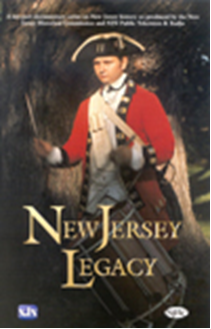New Jersey Legacy

Fortunes in Furs
For centuries, the Lenape Indians lived on the land that would become New Jersey. However, their way of life began to change in 1609 when Henry Hudson explored the Atlantic shoreline. Anticipating potential fortunes from the fur trade, the Dutch established the colony of New Netherland. They soon came into conflict with the Lenape, and then with the English and the Swedes, who also sought control of the region.
The Two New Jerseys
After the English conquest of New Netherland, King Charles II of Britain granted the former Dutch territories to his brother James, Duke of York, who divided the colony into New York and New Jersey. James gave New Jersey to his friends, John, Lord Berkeley, and Sir George Carteret, who sold their shares to other investors, known as proprietors. In 1676, the colony was divided into East and West Jersey. From the outset, the two New Jerseys were beset with problems. In 1702, the proprietors asked the crown to take over the government, reuniting New Jersey.
Royal Rule and Religious Revival
The reunion of East and West Jersey did not solve New Jersey’s problem. New Jersey still shared a governor with New York, and the governor aroused the ire of many New Jerseys. Additionally, land ownership continued to be disputed, resulting in widespread rioting. At the same time, a religious revival, known as the Great Awakening, spread throughout the British colonies, resulting in the founding of Rutgers and Princeton universities. In challenging established church authorities, the revival helped pave the road to the American Revolution.
The Republican Rebellion
New Jersey was the Crossroads of the American Revolution, being strategically located between the British military headquarters in New York City and the Continental Congress sitting in Philadelphia. New Jersey’s role in the American Revolution begins with the protests against the Stamp Act and other British imperial measures, includes the passage of New Jersey’s first state constitution of 1775, and Washington’s stunning victories over the British in the battles of Trenton and Princeton, and concludes with the effects of the Revolution on women and blacks.
Monopolies and Mechanics
Alexander Hamilton’s vision of a manufacturing center at the fall of the Passaic River lays the groundwork for the founding of the Society for Establishing Useful Manufactures in Paterson in 1791. To encourage internal improvements New Jersey chartered corporations and the granted of transportation monopolies to steamboat and railroad companies. The so-called Market Revolution resulted in a fissure in the unified world of masters, journeymen and apprentices of the colonial period. It changed home-life as well as work-life, resulting in a new definition of women’s roles.
Vistas of Democracy
The American Revolution unleashed a flurry of new ideas about freedom and equality. But not everyone in the early nineteenth century enjoyed these rights. While women and free blacks who owned property could vote under New Jersey’s 1776 constitution that right was taken away from them in 1807. African Americans and Quakers helped slaves from the South escape through New Jersey on the Underground Railroad. After the Civil War, the women’s movement split over the Fourteenth and Fifteenth Amendments to the U. S. Constitution, which guaranteed the right to vote to African American men, but not to women.
A State of Many Nations
New Jersey had been ethnically and religiously diverse since colonial times. However, the colonial religious denominations were almost all Protestant. In the early nineteenth century immigration shifted to Germany and Ireland, and many of these newcomers were Catholics. Middle-class reformers attempted to “Americanize” the German and Irish immigrants by promoting temperance and using the newly created public schools to make the immigrants into good Americans (meaning, Protestants). In response, the Germans and Irish created their own parochial schools and requested the state to provide funding.
Technology in the Garden
In 1876, Thomas Alva Edison opened his so-called “invention factory on a hill in Menlo Park overlooking the Pennsylvania Railroad tracks. Between 1876 and 1882 Edison filed more than 300 patents, including the phonograph, the motion picture camera, and the electric light. There were, however, social implications for technological development. When Paterson broad-silk manufacturer Henry Doherty increased the work assignments from two to four looms, his weavers went on strike with the support of the radical Industrial Workers of the World.
The Progressive Banner
In the gubernatorial election of 1910 the Democratic Party nominated the president of Princeton University, Woodrow Wilson. As governor, Wilson proposed reforms, including direct primary elections, banning of ballot box stuffing, an authority to regulate public utilities, and a workmen’s compensation act. The period also witnessed a Great Migration of African Americans from the South to industrial northern cities like Newark and a successful campaign to gain the right to vote for women led by Alice Paul from Mt. Laurel.
The Suburban State
The second half of the twentieth century witnessed a major shift in political power in New Jersey from a coalition of rural Republicans and urban Democrats to the suburbs. The new state constitution of 1947 established a powerful Supreme Court, which became a flashpoint on the issues of school funding and discriminatory zoning.
The series was co-produced by the New Jersey Historical Commission and NJN Public Television.
A co-production of the NJN Public Television and the New Jersey Historical Commission (intended for use in middle and high schools)

